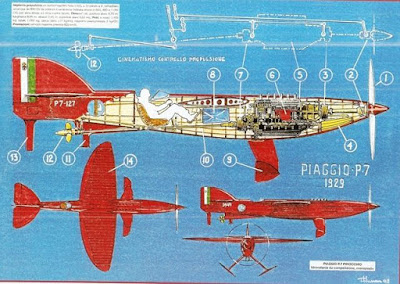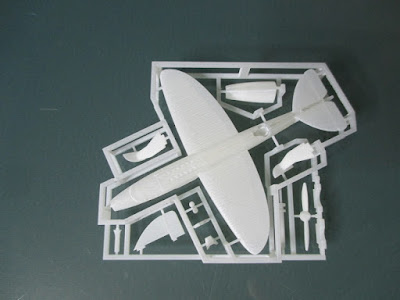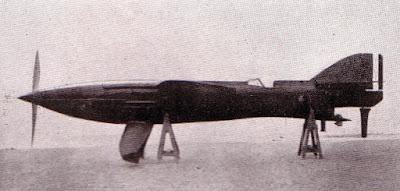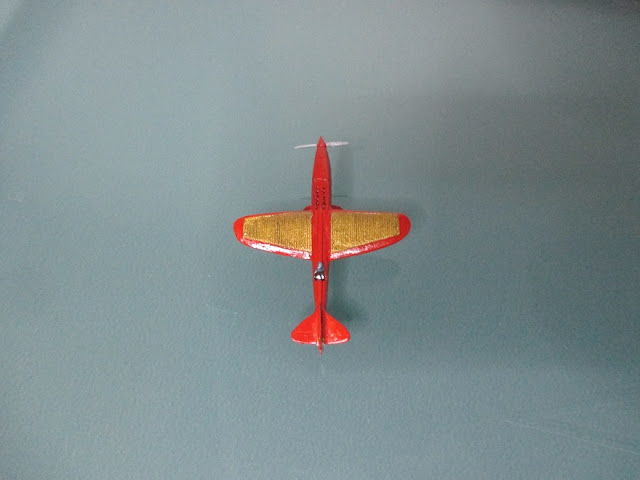Parmi ces hydravions, il en est un, dont hélas il ne reste plus rien, qui est exceptionnel car n'ayant ni flotteurs, ni coque.... : le Piaggio Pegna PC.7 conçu par l'ingénieur italien Pegna de la firme Piaggio.
Son principe était que l'avion flottait sur son fuselage étanche, ses ailes étant posées à la surface de l'eau.
I started to get interested in the Schneider Cup seaplanes after the lucky purchase of a metal kit of Supermarine S6B (see here) which I still have to built, then mostly the visits to the Museo Storico dell'Aeronautica Militare de Vigna di Valle in Italy, with its racing seaplanes collection of Macchi, Fiat etc, one more beautiful than the other (see here).
Among these seaplanes, there is one, of which unfortunately nothing remains, which is exceptional because it has neither floats nor hull... : the Piaggio Pegna PC.7 designed by the Italian engineer Pegna of the firm Piaggio.
Its principle was that the plane floated on its waterproof fuselage, its wings being posed on the surface of the water.
Le moteur avait deux arbres, l'un actionnant une hélice "marine", identique à celle d'un bateau, qui permettait ainsi de se déplacer dans l'eau, puis ayant atteint assez de vitesse, et s'élevant grâce aux hydrofoils de chaque côté du fuselage, l'autre arbre actionnait alors l'autre hélice, celle-ci "aérienne" qui jusqu'alors était en position horizontale pour permettre la navigation.
The engine had two shafts, one activating a "marine" propeller, identical to that of a boat, which thus made it possible to move in the water, then having reached enough speed, and rising thanks to the hydrofoils on each side of the fuselage, the other shaft then activating the other propeller, this one "aerial" which until then had been in a horizontal position to allow navigation.
Entraîné par cette hélice "aérienne", et perché sur ses foils, l'avion pouvait alors effectuer un décollage classique.
Cet avion devait concourir pour la Coupe Schneider de 1929 mais les nombreuses innovations complexes auraient nécessité plus de temps et d'essais.
Cet avion n'a donc jamais volé car il semble également qu'en raison de son instabilité importante lorsqu'il se trouvait sur ses foils et du mauvais rendement de l'hélice "marine", le pilote d'essai n'ait jamais osé mettre en marche l'hélice "aérienne"....
Driven by this "aerial" propeller, and perched on its foils, the plane could then perform a conventional takeoff.
This plane was to compete for the 1929 Schneider Cup, but the many complex innovations would have required more time and testing.
This aircraft therefore never flew because it also seems that due to its considerable instability when it was on its foils and the poor performance of the "marine" propeller, the test pilot never dared start the "aerial" propeller....
Mais on sait que ce concept était valide car, environ 50 ans après, un modèle réduit radiocommandé a réussi (après de nombreux échecs et de tout aussi nombreux essais) à déjauger avec l'hélice marine, à hydroplaner, puis décoller, voler et amerrir (voir ici l'histoire complète de celui qui a réussi).
Aussi, lorsque j'ai vu sur le site Dameya qui le commercialise, alors qu'il est réalisé par V1 Models (voir ici), un kit de Piaggio Pegna PC.7, je n'ai pas réfléchi, je l'ai acheté....
C'était un kit en impression 3D, extrêmement fin (et donc fragile...).
Voir ici l'article "Out of the box" sur le forum Kampfgruppe 144.
But we know that this concept was valid because, about 50 years later, a radio-controlled model succeeded (after many failures and just as many tests) to take off with the marine propeller, to hydroplane, then to take off, to fly and ditch (see here the complete story of the one who succeeded - in french).
So, when I saw on the Dameya website which markets it, while it is produced by V1 Models (see here), a Piaggio Pegna PC.7 kit, I did not think about it, I bought it....
It was a 3D printing kit, extremely thin (and therefore fragile...).
See here the report "Out of the box" on the Kampfgruppe 144 forum.
Il m'a fallu pas mal de temps avant de tenter de mouler et couler ce modèle, que j'ai fait en utilisant un kit en impression 3D de Shapeways, qui est un peu plus épais et solide que le kit de V1 Models, que je n'ai utilisé que pour les foils.
Voici la photo du modèle sorti du moule et avant ébarbage, car on peut voir les renforts pour permettre une meilleure coulée du métal à l'arrière des ailes et ailerons.
It took me quite a while before trying to mold and cast this model, which I did using a 3D printing kit from Shapeways, which is a little thicker and sturdier than the V1 Models kit, which I only used for the foils.
Here is the photo of the model out of the mold and before deburring, because one can see the reinforcements to allow a better casting of the metal at the back of the wings and fins.
En réalité, le plus dur a été de réaliser l'hélice marine...
In reality, the hardest part was making the marine propeller...
Puis après un ébarbage consciencieux pour ne pas abimer la gravure des radiateurs sur et sous les ailes...., un peu de mastic, du ponçage, de la peinture et quelques décalques, voici un Piaggio Pegna PC.7, au 1/144 et en métal.
Then after a conscientious deburring so as not to damage the engraving of the radiators on and under the wings ...., a little putty, sanding, painting and some decals, here is a Piaggio Pegna PC.7, at 1/144 and of metal.
1/144 Piaggio Pegna PC.7
Et pour finir, un petit écrin pour présenter cet hydravion, son atelier....
And finally, a little "jewel box" to present this seaplane, its workshop...
VOIR PLUS - SEE MORE :
Racing aircraft kits
The Thin Red Line - Italian Schneider Race aircraft














Aucun commentaire:
Enregistrer un commentaire